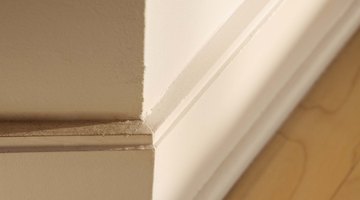What Baseboard Is Better: Plastic or Wood?
While wood is a traditional material for baseboards, you actually have several choices for your baseboard material in modern times. One of these choices is plastic baseboard molding, which you may be interested in using instead of wood. Because the two materials, wood and plastic, have different qualities, it's difficult to say which is better than the other. However, plastic has many positive qualities to offer and may be a better choice than wood depending upon the situation, and vice versa.

Tip
Baseboards aren't the only accessory in your home that may be better in plastic form. There are numerous other high quality plastic materials that can be incorporated into your design plan, including plastic floor tiles, carpeting, countertops and more. Home building and design products made from recycled plastics not only improve the aesthetic of your space, but also help to reduce waste and make a true difference for the environment.
Appearance
Plastic baseboard is designed to look a lot like regular wood baseboard. It may have a "plastic" look, but can be painted, and a coat of paint will make it better resemble regular painted wood baseboard. If you want painted baseboard, then there is not much difference in regards to quality between plastic and real wood baseboard, though the fact that plastic baseboard doesn't need priming can be appealing. However, if you have wooden floors, you may want the baseboard to match. In this case, wood is the better choice. You can faux paint woodgrain, and it's not difficult if you use a woodgrain rocker. However, this approach will be time-consuming. You can also purchase plastic baseboard with a faux grain. However, you have a better chance of matching the color and grain of your wood floor if you use real wood that is the same type with the same stain. (see References 4 and 5)
Flexibility
Wood has a little bit of give to it, but plastic baseboards are much more flexible. Walls are almost always slightly curved, but it might be so subtle that you would never notice. In the case of a wall that has just a little curve to it, the two products are equal. However, if you are installing baseboard on a wall that you know is warped or around a wall that has a severe curve for decorative purposes, plastic is the superior choice because it bends easily without splitting like wood.
Water Resistance
Plastic molding resists water and decay very well. Wood does, too, if it's sealed, but not nearly as well. Mold or insects may be a problem with wood, but not plastic. If you don't have a problem with water or insects, then the two are equally useful choices. However, if you want to put molding in a damp or wet place, such as a bathroom, or if you have trouble with water or humidity in your home, plastic has a lot of appeal.
Installation
Plastic and wood baseboard can be installed in the same general manner, using the same types of tools. You can use saws for both, with a power miter saw being an optimal choice, as well as glue, screws or nails during installation. Plastic has an added bonus: it resists splitting and splintering. However, plastic can be vulnerable in a power saw. The high speed of a power saw can melt the end of the trim, which results in a very unsightly cut. In this instance, wood is the better choice, since this is not an issue with wood. Using a hand saw and miter box is a safer choice with plastic baseboard because it doesn't operate at a high speed, but is more time consuming and a miter box is more limited with angles than a power miter saw. (see Reference 6)
References
Photo Credits
- Jupiterimages/Creatas/Getty Images
- Jupiterimages/Creatas/Getty Images
More Articles



